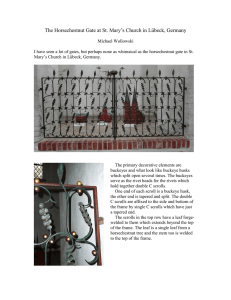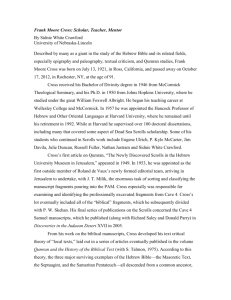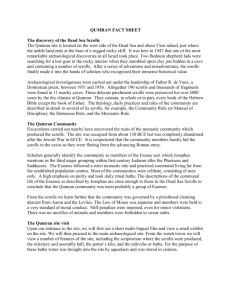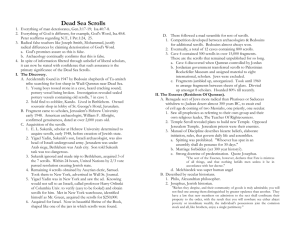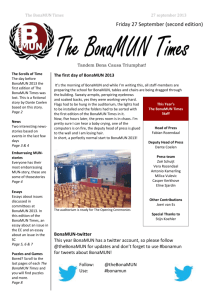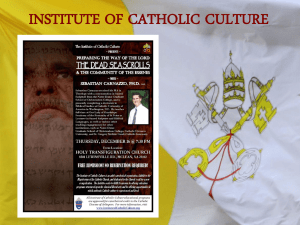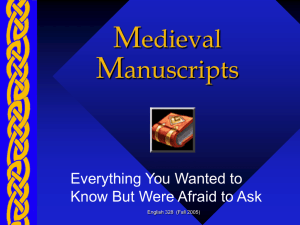Fragments Past of the
advertisement
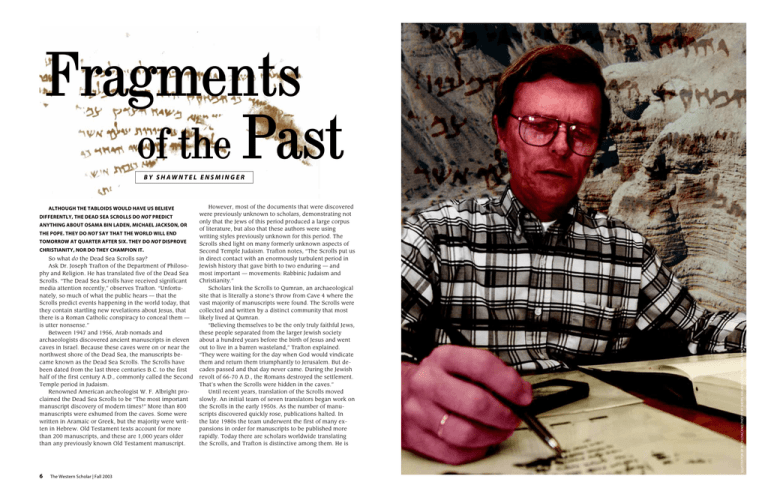
Fragments of the Past BY SHAWNTEL ENSMINGER DIFFERENTLY, THE DEAD SEA SCROLLS DO NOT PREDICT ANYTHING ABOUT OSAMA BIN LADEN, MICHAEL JACKSON, OR THE POPE. THEY DO NOT SAY THAT THE WORLD WILL END TOMORROW AT QUARTER AFTER SIX. THEY DO NOT DISPROVE CHRISTIANITY, NOR DO THEY CHAMPION IT. So what do the Dead Sea Scrolls say? Ask Dr. Joseph Trafton of the Department of Philosophy and Religion. He has translated five of the Dead Sea Scrolls. “The Dead Sea Scrolls have received significant media attention recently,” observes Trafton. “Unfortunately, so much of what the public hears — that the Scrolls predict events happening in the world today, that they contain startling new revelations about Jesus, that there is a Roman Catholic conspiracy to conceal them — is utter nonsense.” Between 1947 and 1956, Arab nomads and archaeologists discovered ancient manuscripts in eleven caves in Israel. Because these caves were on or near the northwest shore of the Dead Sea, the manuscripts became known as the Dead Sea Scrolls. The Scrolls have been dated from the last three centuries B.C. to the first half of the first century A.D., commonly called the Second Temple period in Judaism. Renowned American archeologist W. F. Albright proclaimed the Dead Sea Scrolls to be “The most important manuscript discovery of modern times!” More than 800 manuscripts were exhumed from the caves. Some were written in Aramaic or Greek, but the majority were written in Hebrew. Old Testament texts account for more than 200 manuscripts, and these are 1,000 years older than any previously known Old Testament manuscript. 6 The Western Scholar | Fall 2003 However, most of the documents that were discovered were previously unknown to scholars, demonstrating not only that the Jews of this period produced a large corpus of literature, but also that these authors were using writing styles previously unknown for this period. The Scrolls shed light on many formerly unknown aspects of Second Temple Judaism. Trafton notes, “The Scrolls put us in direct contact with an enormously turbulent period in Jewish history that gave birth to two enduring — and most important — movements: Rabbinic Judaism and Christianity.” Scholars link the Scrolls to Qumran, an archaeological site that is literally a stone’s throw from Cave 4 where the vast majority of manuscripts were found. The Scrolls were collected and written by a distinct community that most likely lived at Qumran. “Believing themselves to be the only truly faithful Jews, these people separated from the larger Jewish society about a hundred years before the birth of Jesus and went out to live in a barren wasteland,” Trafton explained. “They were waiting for the day when God would vindicate them and return them triumphantly to Jerusalem. But decades passed and that day never came. During the Jewish revolt of 66-70 A.D., the Romans destroyed the settlement. That’s when the Scrolls were hidden in the caves.” Until recent years, translation of the Scrolls moved slowly. An initial team of seven translators began work on the Scrolls in the early 1950s. As the number of manuscripts discovered quickly rose, publications halted. In the late 1980s the team underwent the first of many expansions in order for manuscripts to be published more rapidly. Today there are scholars worldwide translating the Scrolls, and Trafton is distinctive among them. He is ILLUSTRATION BY RUTH LOIACANO; PHOTOS BY SHERYL HAGAN-BOOTH, DR. JOSEPH TRAFTON ALTHOUGH THE TABLOIDS WOULD HAVE US BELIEVE Western Kentucky University 7 “Imagine a 1,000-piece jigsaw puzzle with 95 percent of the pieces thrown away and the box top missing. Now take the pieces from many more similarly mistreated puzzles, and mix all of them together. This is the situation that awaits the Dead Sea Scrolls scholar, who is expected not only to separate and identify all the different puzzles, but also to reconstruct the puzzle box tops!” one of only a few scholars not employed by a private institution. Trafton is writing for the Princeton Theological Seminary Dead Sea Scrolls Project, which combines the intellectual talents of 56 contributors from the United States, Israel, England, Germany, and Canada. The set is projected to consist of 13 volumes, six of which have been published. One volume comes out every other year in Germany and the United States simultaneously. Each volume contains entries on individual scrolls that include the Hebrew transcription of the manuscript, a translation from the Hebrew, and an extensive introduction including the document’s date, theology, relation to the Old and New Testaments, and its relation to other Jewish literature of the period. Trafton’s entry on manuscript 4Q252 “Commentary on Genesis A” was published in The Dead Sea Scrolls: 8 The Western Scholar | Fall 2003 Volume 6b: Pesharim, Other Commentaries, and Related Documents in 2002. Trafton calls “Commentary on Genesis A” a fascinating document. “The writer [of the commentary] collected a series of passages from the Old Testament book of “Genesis” and commented upon them. For example, he took the story of Noah and the flood and, ignoring everything related to the building of the ark and to the animals, focused his attention entirely on the passages that dealt with the dates of events in the story. His purpose was to show that the entire story covered one solar [364-day] year. Why? Because the ruling authorities in Jerusalem were using a lunar [354-day] calendar, and it was the community’s belief that God’s preferred calendar is the solar.” The other four entries on documents assigned to Trafton are due to appear in a forthcoming volume of that series. These include a hymn from Cave 3, a hymn PHOTO BY DR. JOSEPH TRAFTON PHOTO BY DR. JOSEPH TRAFTON Ruins at Qumran Recently the University added the Dead Sea Scrolls class from Cave 6, a prayer from Cave 6, and a prayer from to the catalog as a permanent course. Cave 11. “The document from Cave 11 is especially One extraordinary aspect of this class is the Fragments intriguing,” notes Trafton, “because it is closely related Project, an exercise Trafton designed. Students are given to materials from Cave 1 and Cave 4.” an envelope full of fragmentary, damaged manuscripts Working with these texts is challenging because most and work as a team trying to rebuild the manuscripts are more than 2,000 years old. Over time the quality of and decipher what each says. “The Fragments Project the majority of the Scrolls has suffered greatly. Many of offers a unique, hands-on experience to examine the the manuscripts are discolored and are deteriorating obstacles the original Scrolls team encountered,” much more rapidly since they have been removed from according to senior religious studies major Michael the desert caves where they had been since antiquity. Blanton. “Anyone interested in religious textual studies Almost all the manuscripts are fragmentary, some with could benefit.” many pages missing, others missing letters and words, Very few undergraduate religious studies programs and some containing only a single letter or word. are fortunate enough to have a class on the Scrolls. “Imagine a 1,000-piece jigsaw puzzle with 95 percent Such courses are typically found in graduate programs of the pieces thrown away and the box top missing. Now like those at Harvard, Yale, Duke, Princeton, and Notre take the pieces from many more similarly mistreated Dame. “We have seen a dramatic increase in the number puzzles, and mix all of them together,” explains Trafton. of religious studies majors at Western over the last few “This is the situation that awaits the Dead Sea Scrolls years,” observes Trafton. “Courses such as this one give scholar, who is expected not only to separate and identify all the different puzzles, but also to reconstruct the puzzle box tops!” The translator’s job is to fill in the gaps and decipher the blackened parchment. Trafton has visited the Rockefeller Museum in Jerusalem in order to work directly with the fragile manuscripts assigned to him. He had photographs developed at different exposures revealing many previously illegible letters and allowing him to better distinguish the Hebrew. “The manuscript of ‘Commentary on Genesis A’ has been ravaged by time,” according to Trafton. “It has shrunk considerably and is badly wrinkled and torn. The photographs are easier to read than the manuscript itself. On the other hand, the manuscripts of the other four View of Qumran from a cliff documents — though only a few pieces them a competitive edge for graduate school.” In fact, remain of them — are quite legible. Sharp, black letters one recent alumnus became interested in the subject on a light brown background — it is hard to believe they and is currently doing doctoral work at Yale. are over 2,000 years old!” If you study the Dead Sea Scrolls, you won’t find Trafton, who joined Western’s faculty in 1977, first references to contemporary society, but you will find became interested in the Scrolls during his master’s valuable information about Judaism at the time of work at Gordon-Conwell Theological Seminary. He Jesus. None of the Scrolls suggests a day and time for pursued this interest further while earning his doctorate the end of the world, but one Scroll does describe an at Duke University. It was there that he worked under apocalyptic war between the Sons of Light and the Dr. James Charlesworth, the editor of the Princeton Sons of Darkness. They don’t mention Jesus, but they Dead Sea Scrolls Project. do mention a Messiah (or even Messiahs) that they Trafton first taught a course at Western on the Dead expect to come. All in all, the Dead Sea Scrolls are full Sea Scrolls in 1990 as a graduate seminar. It generated of headlines, just not the ones you see in the checkout such demand among students that he has taught a similar line tabloids. Just ask Dr. Joseph Trafton and his course at the undergraduate level off and on ever since. students. They know. Western Kentucky University 9
